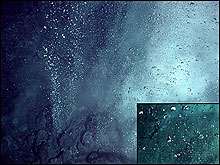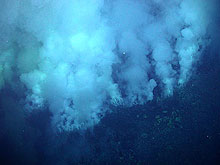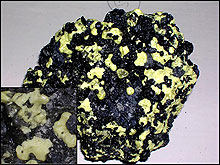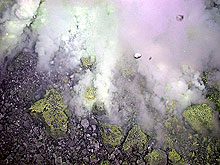In this bubble "curtain," incredible amounts of carbon dioxide (CO2) gas can be seen streaming out from the lava rubble pile, especially at the toe of an advancing lava flow. The image is about 1 m across. A close-up of some of the CO2 bubbles (shown in lower right inset), which wobble and spin as they rise through the water column. Click image for larger view and image credit.
Hades Breath
April 25, 2006
Cornel E.J. de Ronde
Geologist
Institute of Geological and Nuclear Sciences
Lower Hutt, New Zealand
![]() The beauty of a twisting, curling plume as it exits the crater.
(Quicktime, 2.1 Mb.)
The beauty of a twisting, curling plume as it exits the crater.
(Quicktime, 2.1 Mb.)
![]()
![]() A
surprise every five minutes! (Quicktime,
2.1 Mb.)
A
surprise every five minutes! (Quicktime,
2.1 Mb.)
![]() Degassing
of the "toe" of an andesite (fine-grained volcanic rock) lava flow. (Quicktime, 1.8 Mb.)
Degassing
of the "toe" of an andesite (fine-grained volcanic rock) lava flow. (Quicktime, 1.8 Mb.)
![]() Hades
breath: Most definitely poisonous! (Quicktime,
2 Mb.)
Hades
breath: Most definitely poisonous! (Quicktime,
2 Mb.)
![]() One
last hurrah! (Quicktime, 2 Mb.)
One
last hurrah! (Quicktime, 2 Mb.)
What an incredible smorgasbord of events our eyes have been feasting on here at NW Rota-1, one of many submarine volcanoes along the Mariana arc. Only 9 hrs after we surfaced from our 3rd dive on this volcano we were back down there again, 560 m (1,840 ft) below the sea surface, drawn by the excitement of witnessing new lava forming at the summit of the volcano. Yes, right before our eyes! Here's how the events of the past 24 hrs unfolded.
A zoomed-out view looks down on an advancing andesite lava flow (obscured here by the plumes). The yellow parts of the plume contain molten droplets of sulfur; the white parts may contain other mineral particles (like alunite, an aluminum-bearing sulfate). This image represents an area about 2 m across. Click image for larger view and image credit.
After the excitement of the previous dive to Brimstone Pit, we quietly
wondered if it could be surpassed by anything we might see next. How
wrong we were! Our initial approach to Brimstone revealed a line of
bubbles (mainly carbon dioxide) being expelled from a fracture
in the underlying rock, which was similar to the previous dive.
But as we got closer to the pit, something about the layout of the area seemed little odd. That was it! In place of the flat ground
that described Brimstone Pit yesterday, some sort of mound had formed.
In fact, it was a small cinder cone about 6 m (20 ft) in diameter
with walls about 1 m (3.3 ft) high, and was made up entirely of
fine-grained ash. As we approached, we saw a plume building out of the
center of the cone and on closer inspection ![]() we
noticed ash was "raining" out of the bottom of the plume (Quicktime,
2.1 Mb.) and being dumped on the flanks of the small cone. And
so it was built . . . Incredible!
we
noticed ash was "raining" out of the bottom of the plume (Quicktime,
2.1 Mb.) and being dumped on the flanks of the small cone. And
so it was built . . . Incredible!
Newly formed near Brimstone Pit, this piece of andesite lava is about 4 in across. It shows elemental sulfur in-filling the vesicles in the lava. A close-up of the sulfur (shown in the inset), which would have been liquid as it fills the cavities, has an origin in the magmatic gases sulfur dioxide (SO2) and/or hydrogen sulfide (H2S). Click image for larger view and image credit.
Again, we saw gas bubbles coming out of Brimstone Pit. Things
had calmed down. But what's happening over to the right? ![]() A
plume forming from the degassing of newly created lava on the sea floor (Quicktime,
2.1 Mb.).
Wow, it's spectacular! It totally captivates us as it swirls and dances
before our eyes, "hugging" the sea floor as it moves forward. Mesmerizing.
But wait a minute: it's coming straight for us. Let's get out of here!
A
plume forming from the degassing of newly created lava on the sea floor (Quicktime,
2.1 Mb.).
Wow, it's spectacular! It totally captivates us as it swirls and dances
before our eyes, "hugging" the sea floor as it moves forward. Mesmerizing.
But wait a minute: it's coming straight for us. Let's get out of here!
We then ventured off and did a sonar survey a short distance away. As
soon as we could, we returned to Brimstone Pit, drawn to the drama unfolding
below us. Looking around a bit more carefully, ![]() we
witnessed the degassing of a blocky lava flow (Quicktime, 1.8
Mb.). The
rock type is andesite, and it does not flow particularly well; rather,
it advances like some slow moving robot — bit by bit, chunk by chunk.
As the lava advances, the "toe" of the flow vigorously degasses. The
gases are mainly sulfur-rich like sulfur dioxide and hydrogen sulfide,
which upon mixing with the surrounding seawater, can form strong acid(!)
and precipitate elemental sulfur.
we
witnessed the degassing of a blocky lava flow (Quicktime, 1.8
Mb.). The
rock type is andesite, and it does not flow particularly well; rather,
it advances like some slow moving robot — bit by bit, chunk by chunk.
As the lava advances, the "toe" of the flow vigorously degasses. The
gases are mainly sulfur-rich like sulfur dioxide and hydrogen sulfide,
which upon mixing with the surrounding seawater, can form strong acid(!)
and precipitate elemental sulfur. ![]() The
elemental sulfur adds a beautiful yellow hue to the plume (Quicktime, 2 Mb.). We
often see sulfur "raining" on the sea floor as small droplets (the sulfur
was liquid inside the plume) and forming the matrix of the highly vesiculated
lava. That is, the sulfur in-fills the numerous holes in the lava where
the gases escaped. Locally, carbon dioxide forms "waterfalls" of bubbles in front of the advancing
lava. It is these different gases that are the force behind the vigorous
"mini-explosions" within the lava flow. Quite the drama . . . the forceful
main character lava, an accompanying crescendo of blocks of lava and
ash being ejected, the brooding clouds of poisonous gases, the dancing
bubbles of carbon dioxide . . .
The
elemental sulfur adds a beautiful yellow hue to the plume (Quicktime, 2 Mb.). We
often see sulfur "raining" on the sea floor as small droplets (the sulfur
was liquid inside the plume) and forming the matrix of the highly vesiculated
lava. That is, the sulfur in-fills the numerous holes in the lava where
the gases escaped. Locally, carbon dioxide forms "waterfalls" of bubbles in front of the advancing
lava. It is these different gases that are the force behind the vigorous
"mini-explosions" within the lava flow. Quite the drama . . . the forceful
main character lava, an accompanying crescendo of blocks of lava and
ash being ejected, the brooding clouds of poisonous gases, the dancing
bubbles of carbon dioxide . . .
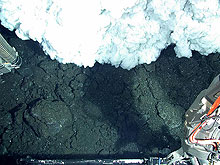
Scientists return to the Brimstone Pit on Dive J2-189 and experience what seems like a "burp" from Hades.
![]() Click
image to view a slide show.
Click
image to view a slide show.




























